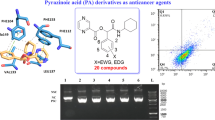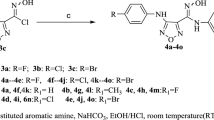Abstract
Quaternary or spirocyclic 3-substituted-3-hydroxy-2-oxindole is considered a privileged scaffold. In other words, it is a molecular core present on several compounds with a wide spectrum of biological activities. Among its precursors, activated ketones (isatin nucleus) can be used as interesting starting points to Morita–Baylis–Hillman adducts derivatives, a class of compounds with good cytotoxic potential. In this paper, we present the synthesis, anti-proliferative activity against lung cancer cell line and a theoretical conformational study of 21 of Morita–Baylis–Hillman adducts from isatin derivatives, by DFT quantum chemical calculations, followed by a SAR and QSAR analysis. Besides, an efficient synthetic protocol and good biological activity profile were highlighted interesting observations about 1H NMR experimental spectra, molecular modeling results and crystallographic data available.
Graphical abstract










Similar content being viewed by others
References
Peddibhotla S (2009) 3-substituted-3-hydroxy-2-oxindole, an emerging new scaffold for drug discovery with potential anti-cancer and other biological activities. Curr Bioact Compd 5:20–38. https://doi.org/10.2174/157340709787580900
Welsch ME, Snyder SA, Stockwel BR (2010) Privileged scaffolds for library design and drug discovery. Curr Opin Chem Biol 14:347–361. https://doi.org/10.1016/j.cbpa.2010.02.018
Monde K, Sasaki K, Shirata A, Takasugi M (1991) Brassicanal C and two dioxindoles from cabbage. Phytochemistry 30:2915–2917. https://doi.org/10.1016/S0031-9422(00)98224-4
Lima-Junior CG, Faheina-Martins GV, Bomfim CC, Dantas BB, Silva EP, de Araújo DAM, Alencar-Filho EB, Vasconcellos MLAA (2016) Synthesis, cytotoxic activity on leukemia cell lines and quantitative structure-activity relationships (QSAR) studies of Morita–Baylis–Hillman adducts. Med Chem 8:602–612. https://doi.org/10.2174/1573406412666160506150924
Lima-Junior CG, Vasconcellos MLAA (2012) Morita–Baylis–Hillman adducts: biological activities and potentialities to the discovery of new cheaper drugs. Bioorg Med Chem 20:3954–3971. https://doi.org/10.1016/j.bmc.2012.04.061
Baylis AB, Hillman MED, German patent 2155113 (1972) Chem Abstr 77 34174q1
Basavaiah D, Reddy BS, Badsara SS (2010) Recent contributions from the Baylis–Hillman reaction to organic chemistry. Chem Rev 110:5447–5674. https://doi.org/10.1021/cr900291g
Santos MS, Coelho F, Lima-Junior CG, Vasconcellos MLAA (2015) The Morita–Baylis–Hillman reaction: advances and contributions from Brazilian chemistry. Curr Org Synt 12:830–852. https://doi.org/10.2174/157017941206150828114416
Sliwoski G, Kothiwale S, Meiler J, Lowe EW Jr (2014) Computational methods in drug discovery. Pharmacol Rev 66(1):334–395. https://doi.org/10.1124/pr.112.007336
Alencar Filho EB, Santos AA, Oliveira BG (2017) A quantum chemical study of molecular properties and QSPR modeling of oximes, amidoximes and hydroxamic acids with nucleophilic activity against toxic organophosphorus agents. J Mol Struc 1133:338–347. https://doi.org/10.1016/j.molstruc.2016.12.035
Pavitha P, Prashanth J, Ramu G, Ramesh G, Mamatha K, Reddy BV (2017) Synthesis, structural, spectroscopic, anti-cancer and molecular docking studies on novel 2-[(Anthracene-9-ylmethylene)amino]-2- methylpropane-1,3-diol using XRD, FTIR, NMR, UV–Vis spectra and DFT. J Mol Struc 1147:406–426. https://doi.org/10.1016/j.molstruc.2017.06.095
Alencar Filho EB, Castro Silva JW, Cavalcanti SCH (2016) Quantitative structure-toxicity relationships and molecular highlights about Aedes aegypti larvicidal activity of monoterpenes and related compounds. Med Chem Res 25:2171–2178. https://doi.org/10.1007/s00044-016-1650-7
Filho EBA, Moraes IA, Weber KC, Rocha GB, Vasconcellos MLAA (2012) DFT/PCM, QTAIM, 1H NMR conformational studies and QSAR modeling of thirty-two anti-Leishmania amazonensis Morita–Baylis–Hillman adducts. J Mol Struc 1022:72–80. https://doi.org/10.1016/j.molstruc.2012.04.051
Bruker (2009) SADABS, APEX2 and SAINT. Bruker AXS Inc., Madison
Burla MC, Caliandro R, Camalli M, Carrozzini B, Cascarano GL, De Caro L, Giacovazzo C, Polidori G, Spagna R (2005) SIR2004: an improved tool for crystal structure determination and refinement. J Appl Crystallogr 38:381–388. https://doi.org/10.1107/S002188980403225XU
Sheldrick GM (2008) A short history of SHELX. Acta Crystallogr Sect A 64:112. https://doi.org/10.1107/S0108767307043930
Farrugia LJ (1997) ORTEP-3 for Windows—a version of ORTEP-III with a Graphical User Interface (GUI). J Appl Cryst 30:565. https://doi.org/10.1107/S0021889897003117
Macrae CF, Bruno IJ, Chisholm JA, Edgington PR, Mccabe P, Pidock E, Monge LR, Taylor R, van de Streek J, Wood PA (2008) New features for the visualization and investigation of crystal structures. J Appl Cryst 41:466–470. https://doi.org/10.1107/S0021889807067908
ACD/ChemSketch Freeware, version 12.01, Advanced Chemistry Development, Inc., Toronto, ON, Canada, www.acdlabs.com, 2015
GaussView, Version 6, Dennington R, Keith TA, Millam JM (2016) Semichem Inc., Shawnee Mission
Frisch MJ, Trucks GW, Schlegel HB, Scuseria GE, Robb MA, Cheeseman JR, Scalmani G, Barone V, Mennucci B, Petersson GA, Nakatsuji H, Caricato M, Li X, Hratchian HP, Izmaylov AF, Bloino J, Zheng G, Sonnenberg JL, Hada M, Ehara M, Toyota K, Fukuda R, Hasegawa J, Ishida M, Nakajima T, Honda Y, Kitao O, Nakai H, Vreven J, Montgomery JA Jr, Peralta JE, Ogliaro F, Bearpark M, Heyd JJ, Brothers E, Kudin KN, Staroverov VN, Kobayashi R, Normand J, Raghavachari K, Rendell A, Burant JC, Iyengar SS, Tomasi J, Cossi M, Rega N, Millam JM, Klene M, Knox JE, Cross JB, Bakken V, Adamo C, Jaramillo J, Gomperts R, Stratmann RE, Yazyev O, Austin AJ, Cammi R, Pomelli C, Ochterski JW, Martin RL, Morokuma K, Zakrzewski VG, Voth GA, Salvador P, Dannenberg JJ, Dapprich S, Daniels AD, Farkas Ö, Foresman JB, Ortiz JV, Cioslowski J, Fox DJ (2009) Gaussian 09, revision A.1. Gaussian Inc, Wallingford
Stewart JJP (2007) Optimization of parameters for semiempirical methods. V. Modification of NDDO approximations and application to 70 elements. J Mol Model 13:1173–1213. https://doi.org/10.1007/s00894-007-0233-4
Becke AD (1993) Density-functional thermochemistry. III. The role of exact exchange. J Chem Phys 98:5648–5652. https://doi.org/10.1063/1.464913
Lee C, Yang W, Parr RG (1988) Development of the Colle–Salvetti correlation-energy formula into a functional of the electron density. Phys Rev B 37:785–789. https://doi.org/10.1103/PhysRevB.37.785
Vosko SH, Wilk L, Nusair M (1980) Accurate spin-dependent electron liquid correlation energies for local spin density calculations: a critical analysis. Can J Phys 58:1200–1211. https://doi.org/10.1139/p80-159
Tetko IV, Gasteiger J, Todeschini R, Mauri A, Livingstone D, Ertl P, Palyulin VA, Radchenko EV, Zefirov NS, Makarenko AS, Tanchuk VY, Prokopenko VVJ (2005) Virtual computational chemistry laboratory–design and description. J Comput Aided Mol Des 19:453–463. https://doi.org/10.1007/s10822-005-8694-y
Teófilo RF, Martins JPA, Ferreira MMC (2009) Sorting variables by using informative vectors as a strategy for feature selection in multivariate regression. J Chemom 23:32–48. https://doi.org/10.1002/cem.1192
Martins JPA, Ferreira MMC (2013) QSAR modeling: a new open source computational package to generate and validate QSAR models. Quim Nova 36:554–560. https://doi.org/10.1590/S0100-40422013000400013
De Oliveira DB, Gaudio AC (2000) BuildQSAR: a new computer program for QSAR analysis. Quant Struct-Activ Relat 19:599–601. https://doi.org/10.1002/1521-3838(200012)19:6%3c599:AID-QSAR599%3e3.0.CO;2-B
Kiralj R, Ferreira MMC (2009) Basic validation procedures for regression models in QSAR and QSPR studies: theory and application. J Braz Chem Soc 20:770–787. https://doi.org/10.1590/S0103-50532009000400021
da Silva BNM, Bastos RS, Silva BV, Pinto AC (2010) Síntese de 5-nitro-isatina e 5-cloro-isatina a partir da isonitrosoacetanilida. Quim Nova 33(10):2279–2282. https://doi.org/10.1590/S0100-40422010001000043
de Souza ROMA, Vasconcellos MLAA (2004) Intrinsic catalytic activity of tertiary amines: a mechanistic proposal to the unexpected temperature effect in Baylis–Hillman reaction. Catal Commun 5:21–24. https://doi.org/10.1016/j.catcom.2003.11.004
Lima-Junior CG, Silva FPL, Oliveira RG, Subrinho FL, Vasconcellos MLAA (2011) Microwave irradiation or low temperature improved synthesis of antiparasitic Morita–Baylis–Hillman adducts. J Braz Chem Soc 22:2220–2224. https://doi.org/10.1590/S0103-50532011001100028
Cee VJ, Volak LP, Chen Y, Bartberger MD, Tegley C, Arvedson T, Mccarter J, Tasker AS, Fotsch C (2015) Systematic study of the glutathione (GSH) reactivity of N-arylacrylamides: 1. Effects of aryl substitution. J Med Chem 58:9171–9178. https://doi.org/10.1021/acs.jmedchem.5b01018
Singh RM, Bharadwaj KC, Tiwari DK (2014) Morita–Baylis–Hillman reaction of acrylamide with isatin derivatives. Beilstein J Org Chem 10:2975–2980. https://doi.org/10.3762/bjoc.10.315
Mossman T (1983) Rapid colorimetric assay for cellular growth and survival: application to proliferation and cytotoxicity assays. J Immunol Methods 65:55–63. https://doi.org/10.1016/0022-1759(83)90303-4
Fortes MP, da Silva PBN, da Silva TG, Kaufman TS, Militão GCG, Silveira CC (2016) Synthesis and preliminary evaluation of 3-thiocyanato-1H-indoles as potential anticancer agents. Eur J Med Chem 118:21–26. https://doi.org/10.1016/j.ejmech.2016.04.039
Fleming FF, Yao L, Ravikumar PC, Funk L, Shook BC (2010) Nitrile-containing pharmaceuticals: efficacious roles of the nitrile pharmacophore. J Med Chem 53:7902–7917. https://doi.org/10.1021/jm100762r
Donald LP, Gary ML, George SK, James RV (2009) Introduction to spectroscopy. Brooks/Cole CENGAGE Learning, USA
Ren Q, Huang J, Wang L, Li W, Liu H, Jiang X, Wang J (2012) Highly efficient assembly of 3-hydroxy oxindole scaffold via a catalytic decarboxylative 1,2-addition strategy. ACS Catal 2(12):2622–2625. https://doi.org/10.1021/cs300628w
Acknowledgements
The authors are grateful to the Foundation of Support to the Science and Technology of the State of Pernambuco—FACEPE, National Council for Scientific and Technological Development––CNPQ, Coordination of Improvement of Higher Level Personnel—CAPES, Federal University of San Francisco Valley—UNIVASF, for financial support, National High-performance Processing Center of Federal University of Ceará—CENAPAD-UFC for some computational facilities as Gaussian 09 W package, Laboratory of Chromatography and Mass Spectrometry (LaCEM), Institute of Chemistry, Federal University of Goiás (Prof. Dr. Boniek Gontijo Vaz) for mass spectrometry analyses.
Author information
Authors and Affiliations
Corresponding authors
Ethics declarations
Conflict of interest
The authors declare that they have no conflict of interest.
Additional information
Publisher’s Note
Springer Nature remains neutral with regard to jurisdictional claims in published maps and institutional affiliations
Electronic supplementary material
Below is the link to the electronic supplementary material.
Rights and permissions
About this article
Cite this article
Brito, V.B.M., Santos, G.F., Silva, T.D.S. et al. Synthesis, anti-proliferative activity, theoretical and 1H NMR experimental studies of Morita–Baylis–Hillman adducts from isatin derivatives. Mol Divers 24, 265–281 (2020). https://doi.org/10.1007/s11030-019-09950-7
Received:
Accepted:
Published:
Issue Date:
DOI: https://doi.org/10.1007/s11030-019-09950-7




